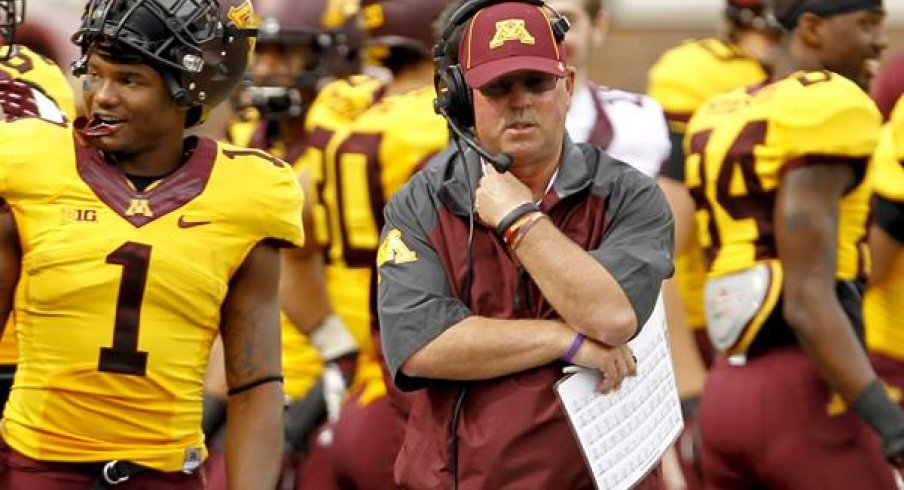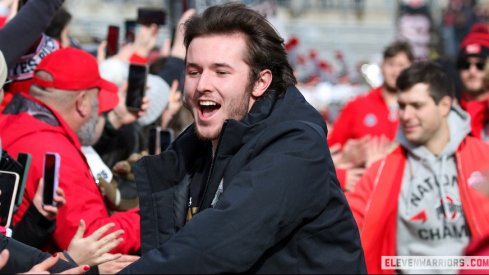Minnesota spent the fall of 2013 as the Big Ten’s darling and a national storyline. As head coach Jerry Kill took a leave of absence due to recurring seizures, defensive coordinator Tracy Claeys guided the Golden Gophers on a journey fit for a Hollywood script.
There was much anticipation for the season in Minneapolis. Ohio State routinely attracts 60,000-plus to its spring games, but that’s not the case for perpetually downtrodden – and cold – Minnesota. When more than 8,000 people showed up for last year’s spring game, Kill and Co. knew the fans were brimming with excitement.
Kill’s health issues have been well documented, and the unfortunate reality struck again last October. He had another seizure during a game in September didn’t travel with Minnesota for a game at Michigan, ultimately taking a leave of absence. After starting the year 4-0, consecutive losses had many believing the Gophers spoiled a notable start. Instead, Kill’s troubles galvanized the team.
A four-game win streak, including victories over a ranked Nebraska team and Penn State, thrust Minnesota into the top 25 for the first time since 2008. It lost a heartbreaker to Syracuse in the Texas Bowl, but an 8-5 record – Minnesota’s best in a decade – stirred more excitement around the program.
And 2014 sets up for continued success. Fourteen starters return – seven on both sides of the ball – and a defense that only allowed 22.2 points per game could be improved.
“I think any time you come off a good year — we didn’t finish exactly the way you want to — but we had a good year and kept moving the program forward,” Kill said this spring. “I think the biggest thing is the kids gained some confidence throughout the year. They were certainly disappointed, but that’s a situation where we all were. We came right back, watched the film and got to work.”
Then the offseason happened.
First, defensive end Ra’Shede Hageman graduated. The surprise came when quarterback Philip Nelson, who’d engineered so much enthusiasm the previous season, transferred to Rutgers. (He’s since been kicked off the team and is facing assault charges.) Even after producing 2,727 yards of offense and 23 touchdowns the past two seasons, Nelson wanted an offense that better suited his skills.
Now the job belongs to Mitch Leidner. The spring game only saw one touchdown and Leider was just 7-of-15 passing for 74 yards. But it was he who resuscitated the Minnesota offense in the Texas Bowl after going over three games without an offensive touchdown. In the spring, he took on another responsibility: team leader.
| Date | Opponent |
|---|---|
| 8/28 | Eastern Illinois |
| 9/6 | Middle Tenn. State |
| 9/13 | @ TCU |
| 9/20 | San Jose State |
| 9/27 | @ Michigan |
| 10/11 | Northwestern |
| 10/18 | Purdue (HC) |
| 10/25 | @ Illinois |
| 11/8 | Iowa |
| 11/15 | Ohio State |
| 11/22 | @ Nebraska |
| 11/29 | @ Wisconsin |
“They just want me to step up, become more of a leader and really take this team by the reigns, really push the guys throughout this offseason and into the season,” Leidner said of the coaches.
A positive bowl game experience presented the beginning stages of confidence for Leidner. It has been elevated more in the offseason. His work ethic will never be questioned and setting an upbeat tone added credibility in the locker room. Another spark comes from Kill, who continues working despite health concerns.
Minnesota’s upward tick – its been to bowl games the past two seasons – led to Kill’s contract being extended through 2018 and his salary was bumped up to $2.1 million. Leidner said Kill’s offered loads of inspiration to the team. Kill downplays his role.
“Everybody has a struggle or two, but you bounce back,” he said. “I still believe it determines what kind of person you are with how you handle adversity. Anybody can handle things good when everything’s going good.”
The Gophers’ offense was not always going good a year ago. They ranked 11th in the Big Ten and had one of the worst passing attacks in the country. The running game was solid, thanks to Nelson and running back David Cobb. He rushed for 1,200 yards and is eager to back up his total. Berkley Edwards, Rodrick Williams and Donnell Kirkwood make tailback perhaps the deepest position on the field.
Helping the backfield is an offensive line that returns almost fully intact. The quarterback-receiver connection must improve, and it could begin with tight end Maxx Williams. The freshman had 417 yards receiving and five touchdowns last season. Wideouts remain a huge concern, where Derrick Engel graduated and Drew Wolitarsky, Donovahn Jones and K.J. Maye remain. A group of talented freshmen may be the answer in upping Minnesota’s meager 148 yards passing average from 2013.
Hageman and Brock Vereen’s losses will be felt on defense. The line should still be imposing, though. Theiren Cockran, who led the team with 7.5 sacks last season, is back. He’ll need his line mates to better their mark of 18 sacks in 2013.
A linebacker corps that lost Cody Poock to a torn ACL shouldn’t have a tremendous drop off, because Jack Lynn and De’Vondre Campbell provide stability. The real strength is in the secondary, where Damarius Travis, Briean Boddy-Calhoun, Eric Murray, Jalen Myric and Derrick Wells roam the land.
Residents of the Twin Cities – Kill included – were delighted after winning eight games last year. But they don’t believe the voyage ends here. Kill believes it’s only beginning, a starting point for a grand excursion.
Minnesota hasn’t won a Big Ten championship since 1967. Ending that streak of futility is Kill’s top objective.
“Our kids have been enthusiastic all spring. They’re eager,” he said. “I don’t like going back in the past. But after that bowl game, I said: ‘You better be starving because that ain’t going to happen anymore.’ So they’ve been back on a mission.”


